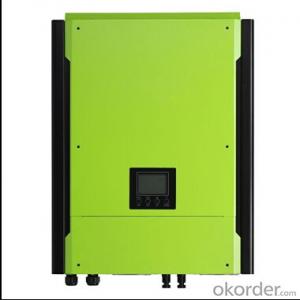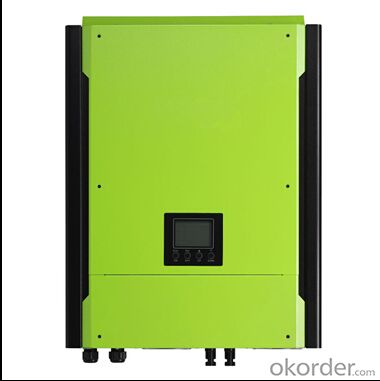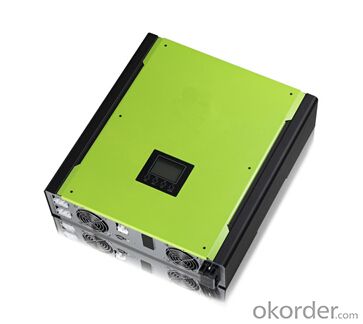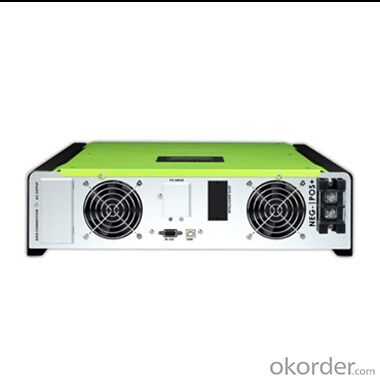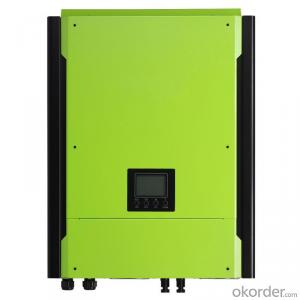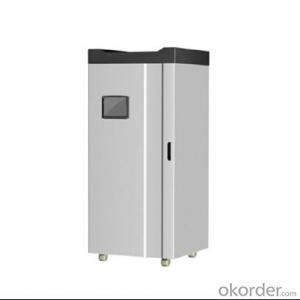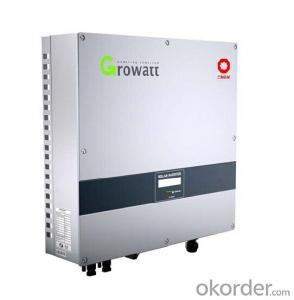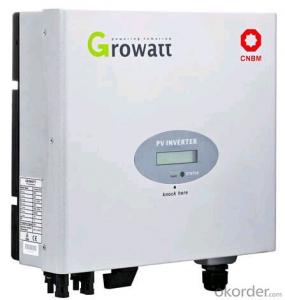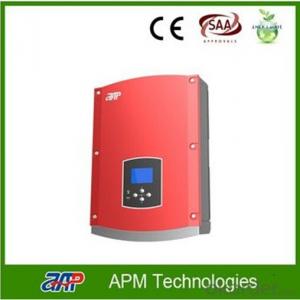400W Solar Inverter On-Grid Energy Storage PV Inverter PH500 Series 1-Phase 2KW
- Loading Port:
- China main port
- Payment Terms:
- TT or LC
- Min Order Qty:
- 60000 watt
- Supply Capability:
- 16000000 watt/month
OKorder Service Pledge
OKorder Financial Service
You Might Also Like
1. Structure of On-Grid Energy Storage PV Inverter Description
On-Grid Energy Storage PV Inverter is a hybrid inverter which combines solar system, AC utility, and battery power source to supply continuous power• It is suitable for the remote areas where the cost of utility is too high or emergency usage when utility is not stable.
2. Main Features of the On-Grid Energy Storage PV Inverter
• 2KW on-grid inverter with energy storage
• Pure sine wave output
• Microprocessor controlled to guarantee stable charging system
• Multiple operations: Grid tie, Off grid, and grid-tie with backup
• Built-in MPPT solar charger
• LCD display panel for comprehensive information
• Multiple communication
• Green substitution for generators
• User-adjustable battery charging current
3. On-Grid Energy Storage PV Inverter Images
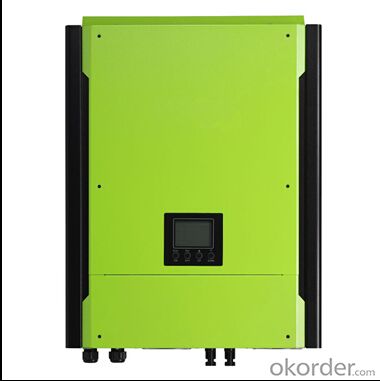
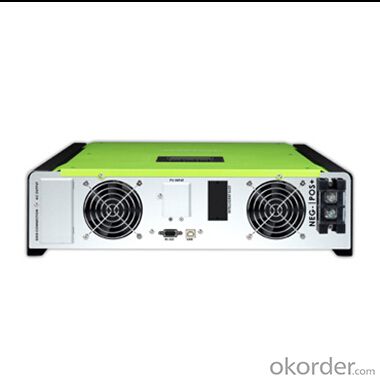
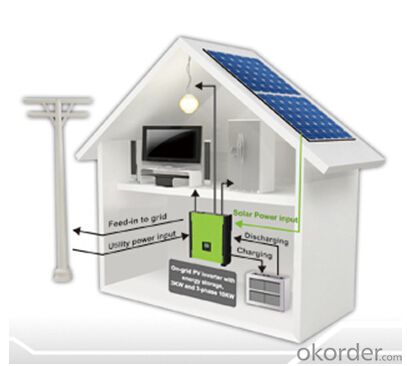
4. On-Grid Energy Storage PV Inverter Specification
Model | PH500 Single-phase 2KW |
RATED POWER | 2000 W |
GRID-TIE OPERATION | |
PV INPUT (DC) | |
Maximum DC Power | 2250W |
Nominal DC Voltage / Maximum DC Voltage | 300 VDC / 350 VDC |
Start-up Voltage / Initial Feeding Voltage | 80 VDC / 120 VDC |
MPP Voltage Range | 150 VDC ~ 320 VDC |
Number of MPP Trackers / Maximum Input Current | 1 / 1 x 15 A |
GRID OUTPUT (AC) | |
Nominal Output Voltage | 101/110/120/127 VAC |
Output Voltage Range | 88 - 127 VAC* |
Nominal Output Current | 18 A |
Power Factor | > 0.99 |
EFFICIENCY | |
Maximum Conversion Efficiency (DC/AC) | 0.95 |
European Efficiency@ Vnominal | 0.94 |
OFF-GRID OPERATION |
|
AC INPUT | |
AC Start-up Voltage/Auto Restart Voltage | 60 - 70 VAC / 85 VAC |
Acceptable Input Voltage Range | 85 - 130 VAC* |
Number of MPP Trackers / Maximum Input Current | 30 A |
PV INPUT (DC) | |
Maximum DC Voltage | 350 VDC |
MPP Voltage Range | 150 VDC ~ 320 VDC |
Maximum Input Current | 1 / 1 x 15 A |
BATTERY MODE OUTPUT (AC) | |
Nominal Output Voltage | 101/110/120/127 VAC |
Output Waveform | Pure Sinewave |
Efficiency (DC to AC) | 0.9 |
HYBRID OPERATION | |
PV INPUT (DC) | |
Nominal DC Voltage / Maximum DC Voltage | 300 VDC / 350 VDC |
Start-up Voltage / Initial Feeding Voltage | 80 VDC / 120 VDC |
MPP Voltage Range | 150 VDC ~ 320 VDC |
Maximum Input Current | 1 / 1 x 15 A |
GRID OUTPUT (AC) | |
Nominal Output Voltage | 101/110/120/127 VAC |
Output Voltage Range | 88-127 VAC |
Nominal Output Current | 18 A |
AC INPUT | |
AC Start-up Voltage/Auto Restart Voltage | 60 - 70 VAC / 85 VAC |
Acceptable Input Voltage Range | 80 - 130 VAC* |
Maximum AC Input Current | 30 A |
BATTERY MODE OUTPUT (AC) | |
Nominal Output Voltage | 101/110/120/127 VAC |
Efficiency (DC to AC) | 0.9 |
BATTERY & CHARGER | |
Nominal DC Voltage | 48 VDC |
Maximum Charging Current | 25A |
GENERAL | |
PHYSICAL | |
Dimension, D x W x H (mm) | 420 x 415 x 170 |
Net Weight (kgs) | 15.5 |
INTERFACE | |
Communication Port | RS-232/USB |
Intelligent Slot | Optional SNMP, Modbus, and AS-400 cards available |
ENVIRONMENT | |
Humidity | 0 ~ 90% RH (No condensing) |
Operating Temperature | 0 to 40°C |
Altitude | 0 ~ 1000 m** |
5. FAQ of On-Grid Energy Storage PV Inverter
Q1. What is the difference between inverter and On-Grid Energy Storage PV Inverter?
A1. Inverter only has AC inpput, but On-Grid Energy Storage PV Inverter both connect to AC input and solar panel, it saves more power.
Q2. What is the difference between MPPT&PWM?
A2. MPPT has higher efficiency, it can track the max power point and won't waste energy.
Q3. What is the waranty of product?
A3. 12 months.
- Q: How does shading impact the performance of a solar inverter?
- Shading can significantly impact the performance of a solar inverter by reducing the overall energy production of the solar panels. When certain parts of the solar panel are shaded, it creates an imbalance in the current flow, resulting in a decrease in the energy output. This can lead to a decline in the overall efficiency and power generation of the solar inverter. To mitigate this issue, technologies like bypass diodes are used in solar panels to minimize the impact of shading and ensure optimal performance.
- Q: Can a solar inverter be used with a string inverter system?
- No, a solar inverter cannot be used with a string inverter system. Solar inverters and string inverters are two different types of inverters that serve different functions in a solar power system. A solar inverter is designed to convert the DC power generated by solar panels into AC power for use in homes or businesses. On the other hand, a string inverter is used to convert the DC power generated by multiple solar panels connected in series, known as a string, into AC power. Therefore, these two types of inverters are not compatible with each other.
- Q: What is the expected lifespan of a solar inverter?
- The expected lifespan of a solar inverter typically ranges from 10 to 20 years. However, this can vary depending on factors such as the quality of the inverter, maintenance practices, and environmental conditions.
- Q: How does a solar inverter handle voltage drop?
- A solar inverter handles voltage drop by continuously monitoring the voltage levels from the solar panels. It adjusts its output voltage accordingly to ensure that the electricity being produced is compatible with the grid or the appliances it is connected to. This helps to compensate for any voltage drop that may occur due to factors such as distance, resistance, or shading, thereby maintaining a consistent and stable power supply.
- Q: Can a solar inverter be used for commercial-scale solar installations?
- Yes, a solar inverter can be used for commercial-scale solar installations. Solar inverters are essential components of any solar PV system, converting the DC electricity generated by solar panels into AC electricity suitable for commercial use. They are available in various sizes and capacities, allowing them to accommodate the power requirements of large-scale commercial installations. Additionally, advanced features like grid-tie functionality and monitoring capabilities make solar inverters suitable for integration into commercial-scale solar installations.
- Q: How do you monitor the performance of a solar inverter?
- To monitor the performance of a solar inverter, several methods can be employed. Firstly, real-time monitoring of key parameters such as voltage, current, and power output can be done using specialized monitoring devices or software. These tools provide a comprehensive overview of the inverter's performance, allowing for immediate identification of any issues or deviations from expected performance. Additionally, regular inspection and maintenance checks are crucial for performance monitoring. This involves visually inspecting the inverter for any physical damage or abnormalities, as well as checking the connections and wiring. Any signs of wear or malfunction should be promptly addressed to ensure optimal performance. Furthermore, data logging and analysis play a vital role in monitoring the inverter's performance over time. By collecting and analyzing historical data, trends and patterns can be identified, helping to detect potential issues or performance degradation. This can be done using software platforms that track and analyze the data from the inverter. Overall, a combination of real-time monitoring, regular inspections, and data analysis allows for effective performance monitoring of solar inverters, ensuring their optimal functioning and addressing any performance issues promptly.
- Q: Can a solar inverter be used in regions with high altitude conditions?
- Yes, a solar inverter can be used in regions with high altitude conditions. However, it is important to consider the specific requirements and limitations of the particular solar inverter model being used. High altitude conditions may affect the performance and efficiency of the inverter, as factors like lower air density and temperature can impact its cooling capacity. Therefore, it is crucial to select a solar inverter that is specifically designed and tested for high altitude operations to ensure optimal performance and reliability.
- Q: What is the maximum AC output current that a solar inverter can provide?
- The maximum AC output current that a solar inverter can provide depends on its specifications and capacity. Different models and brands may have varying maximum AC output current ratings, typically ranging from a few amps to several hundred amps. It is important to consult the specific technical specifications of a particular solar inverter to determine its maximum AC output current capacity.
- Q: What is the role of maximum power control in a solar inverter?
- The role of maximum power control in a solar inverter is to optimize the power output of the photovoltaic (PV) system by continuously tracking the maximum power point (MPP) of the solar panels. This control mechanism ensures that the inverter extracts the maximum amount of energy from the PV array, despite variations in solar irradiation and temperature. By constantly adjusting the inverter's operating conditions to match the MPP, maximum power control maximizes the overall efficiency and performance of the solar power system.
- Q: What is the maximum DC input voltage for a solar inverter?
- The maximum DC input voltage for a solar inverter typically depends on the specific model and manufacturer. However, in general, the maximum DC input voltage for a solar inverter can range from around 500 volts to 1000 volts or more. It is important to consult the manufacturer's specifications for the specific solar inverter being used to determine the exact maximum DC input voltage.
Send your message to us
400W Solar Inverter On-Grid Energy Storage PV Inverter PH500 Series 1-Phase 2KW
- Loading Port:
- China main port
- Payment Terms:
- TT or LC
- Min Order Qty:
- 60000 watt
- Supply Capability:
- 16000000 watt/month
OKorder Service Pledge
OKorder Financial Service
Similar products
Hot products
Hot Searches
Related keywords
